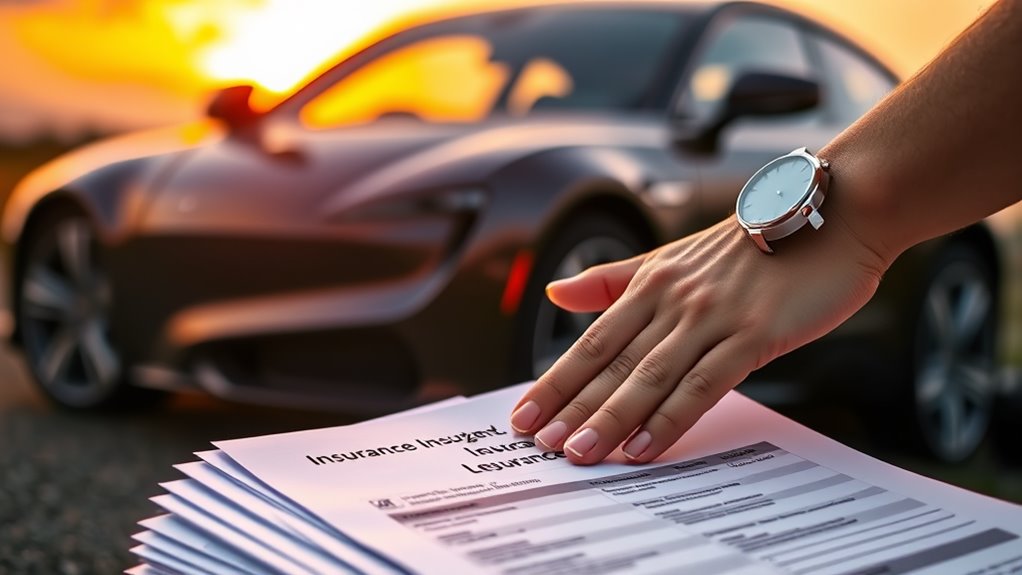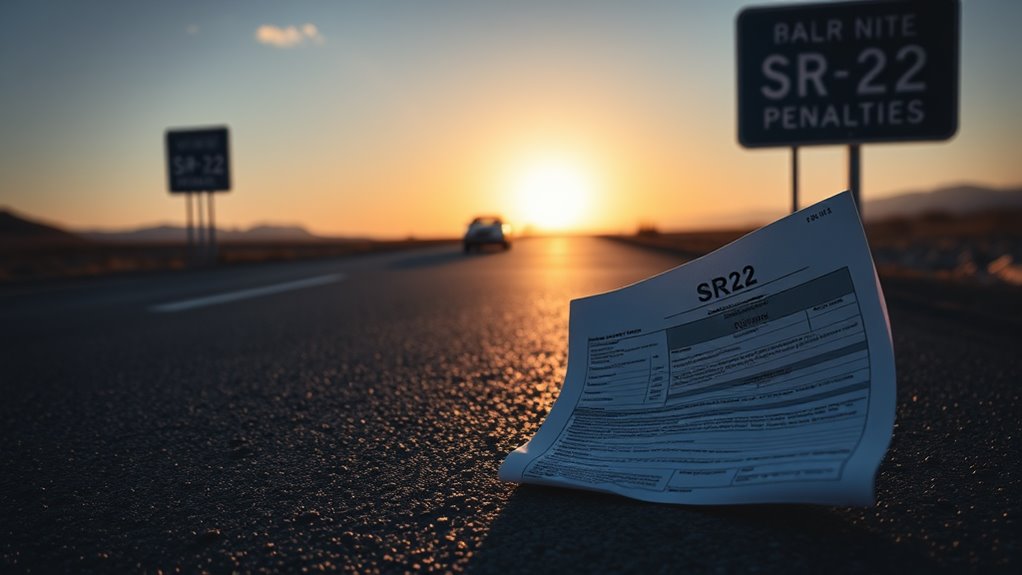Maneuvering the labyrinth of SR22 requirements can feel like walking a tightrope; one misstep could extend your obligations considerably. Several critical factors determine how long you'll need to maintain this insurance, from the severity of your offense to your state's specific regulations. Understanding these elements can help you plan your journey to restored driving privileges. Let's explore the nuances that could influence your SR22 duration, and why staying informed is essential.
Key Takeaways
- The severity of the offense, such as DUI or reckless driving, significantly influences the length of the SR22 requirement.
- Repeat offenses typically lead to longer SR22 durations compared to first-time offenders due to increased risk factors.
- State-specific regulations vary, with some states imposing longer SR22 durations for serious infractions and multiple violations.
- Driving history, including previous infractions and compliance with insurance requirements, affects the duration of the SR22 mandate.
- Compliance with court mandates and timely submission of SR22 documentation are crucial for avoiding extended durations.
Offense Severity and Its Impact

When it comes to SR22 duration, the severity of your offense plays a vital role in determining how long you'll need to maintain this certificate. Serious violations, like DUI or DWI convictions, often result in longer SR22 durations, typically exceeding three years. If you've accumulated multiple offenses or engaged in reckless driving, your filing period might extend even further. Driving without insurance, especially after an accident, can also lengthen your SR22 requirement. Generally, a standard SR22 lasts for three years, but less severe infractions may only require two years. Conversely, very serious offenses could necessitate an SR22 for five years or more. Understanding these factors is essential for managing your driving record and insurance costs effectively. Additionally, maintaining continuous auto insurance coverage during the SR22 period is crucial to avoid penalties and potential license suspension. Furthermore, it's important to remember that non-owner SR-22 insurance can provide coverage even when you do not own a vehicle, which can be beneficial during this period.
State-Specific SR22 Duration Variations
While the duration of SR22 requirements can vary greatly across states, understanding these differences is essential for anyone facing such mandates.
For instance, states like Alabama, Florida, and Georgia typically impose a three-year SR22 requirement for serious offenses.
Meanwhile, Arkansas can extend the duration to five or even ten years for multiple infractions.
Arkansas can impose SR22 requirements for up to ten years if multiple offenses are involved.
States such as Iowa require a shorter period of only two years.
Remarkably, Michigan doesn't specify a duration, so you must check local regulations.
In contrast, Pennsylvania doesn't require SR22 at all, emphasizing the importance of knowing your specific state's rules.
Driving History and Previous Infractions
Your driving history plays an essential role in determining the duration and necessity of SR22 requirements. If you've committed severe offenses like DUI or driving without insurance, your SR22 duration will likely extend.
The type and frequency of infractions matter too; multiple violations in a short period can mark you as a high-risk driver, necessitating SR22 filing. This classification not only leads to mandatory insurance coverage but also increases your premiums.
Furthermore, serious infractions remain visible to law enforcement and insurers for years, affecting your insurance options. To mitigate these impacts, maintaining a clean driving record post-SR22 can help lower future rates and improve your overall risk profile, guiding you toward more favorable insurance conditions.
Repeat Offenses and Extended Requirements
Repeat offenses can markedly extend the duration of your SR22 requirements, leading to a more complex and costly insurance landscape.
If you find yourself facing multiple infractions, expect longer SR22 durations compared to first-time offenders. States often impose harsher penalties for repeat offenses, which can include extended license suspensions and increased fines.
The cumulative effect of multiple offenses in a short period can further exacerbate your situation, resulting in even steeper insurance rates. Additionally, the severity of these offenses, particularly with serious infractions like DUIs, notably impacts the length of your SR22 requirement.
States vary in their regulations, with some, like Michigan, mandating longer durations than others, emphasizing the need for awareness of your state's specific laws.
Types of Convictions Affecting Duration
Understanding the types of convictions that lead to SR22 requirements is essential for maneuvering the complexities of insurance after a driving infraction.
DUI/DWI convictions often necessitate SR22 filings for up to three years, depending on state laws, and typically result in higher premiums.
Reckless driving can trigger similar requirements, especially after accidents or multiple citations.
Driving without insurance commonly leads to SR22 mandates that span from one to three years.
Serious accidents without insurance can further extend the SR22 duration due to severity.
Finally, multiple traffic violations can activate SR22 needs when points exceed thresholds, impacting your insurance rates and long-term options.
Each conviction type carries distinct implications for your insurance journey.
Court Orders and Legal Mandates
When a court issues a mandate for SR22 insurance, it directly impacts your ability to drive legally and maintain financial responsibility. Courts typically require SR22 following serious offenses like DUI or reckless driving, with judges having the discretion to set terms based on the offense's severity.
The duration of your SR22 requirement can range from one to three years, influenced by the specifics of your case. During this time, compliance is closely monitored, and any violations can lead to extended mandates or additional penalties.
Official court notices initiate the SR22 process, requiring your insurer to file the necessary documentation. Ultimately, fulfilling these legal mandates is essential for license reinstatement and avoiding further legal complications.
Insurance Compliance and Coverage Gaps
Insurance compliance is essential during the SR22 period, as any lapses in coverage can lead to significant consequences. If you let your policy lapse, you risk immediate suspension of your driving privileges and may face an extended SR22 requirement.
Texas mandates minimum liability coverage of $30,000 for bodily injury per person and $25,000 for property damage, so maintaining these limits is vital. Non-owner SR22 policies are available for those without a vehicle, ensuring you're still covered.
DMV Regulations and Enforcement Practices
While steering through the complexities of SR22 requirements, it's crucial to recognize that DMV regulations and enforcement practices play a considerable role in your compliance journey.
Each state has varying SR22 durations, typically lasting one to three years based on offense severity. DMVs closely monitor compliance; failure to adhere can lead to license suspension or additional penalties.
Enforcement intensity differs by location, with urban areas usually imposing stricter oversight. Your driving record considerably influences monitoring levels. Additionally, insurance providers must report coverage lapses, ensuring strict enforcement.
Clear communication from DMVs regarding filing procedures and potential costs aids your understanding. Remember, court orders often mandate SR22s, and repeated offenses can extend your required duration.
Stay informed to navigate these regulations successfully.
Economic Implications of SR22 Requirements
Understanding the economic implications of SR22 requirements is essential, especially if you've faced a DUI or similar offense. SR22 often leads to soaring insurance premiums, typically increasing by 20% to 60%.
Factors like your vehicle's age, location, and even personal demographics, such as age and credit score, further influence these costs. The financial burden doesn't stop there; job opportunities may dwindle in fields requiring clean driving records, impacting your income.
Vehicle age, location, and personal factors like age and credit score significantly affect insurance costs and job prospects.
Additionally, the risk of policy cancellation can create a cycle of fines and license suspensions. With fewer insurance providers willing to cover high-risk drivers, you might face limited options, resulting in long-term economic consequences that extend beyond mere premiums.
Planning is vital to manage these ongoing costs effectively.
Restoration of Driving Privileges and Conditions
Restoring your driving privileges after a DUI conviction involves maneuvering through a series of specific conditions and requirements.
First, understand the suspension period, which can last from 12 months to 3 years, depending on your offense history.
You'll need to install an ignition interlock device (IID) and secure an SR-22 certificate to prove financial responsibility.
Full payment of any fines and costs is essential, along with completing the Virginia Alcohol Safety Action Program, especially if you've had multiple offenses.
If seeking a restricted license, apply promptly, as it permits driving for specific purposes.
Conclusion
In maneuvering the complexities of SR22 duration, every factor plays an essential role in shaping your experience. From the severity of your offense to state-specific regulations, each element can drastically alter the length of your requirement. As you consider your driving future, remember that compliance is key, but what happens if you slip up? The stakes are high, and understanding these influences could be the difference between regaining your freedom or facing extended restrictions. Are you prepared for the journey ahead?





